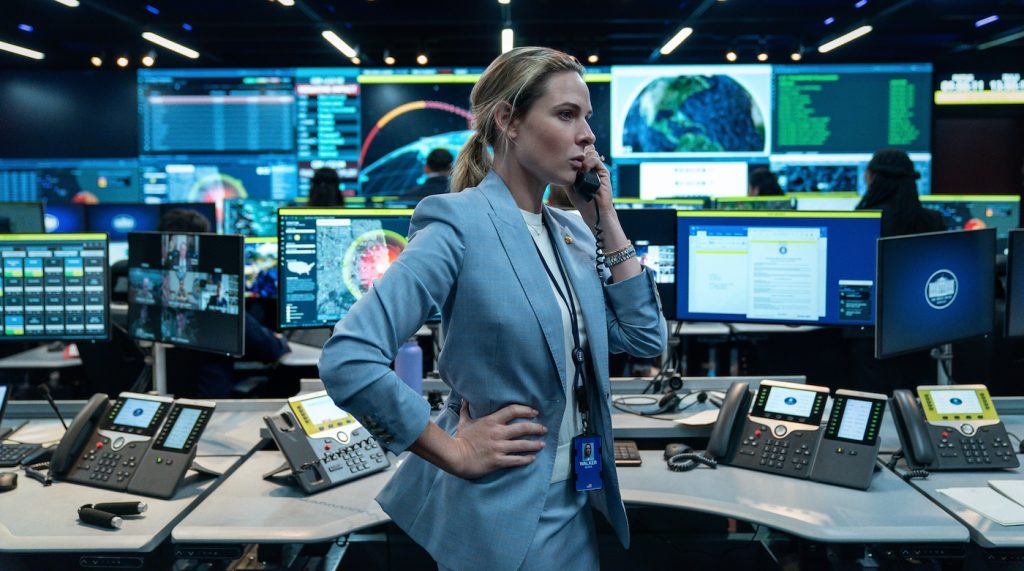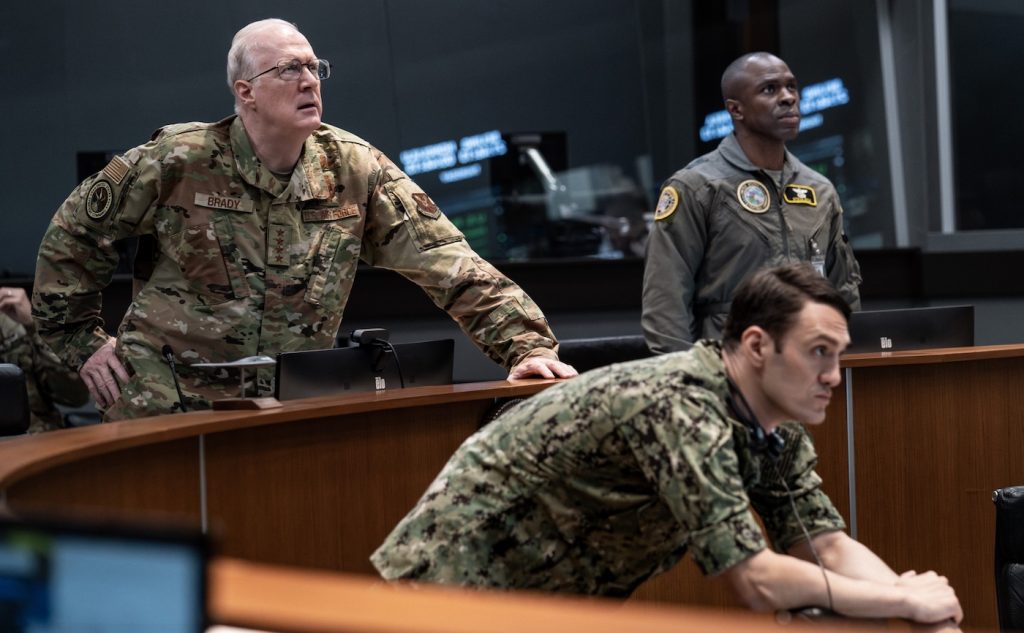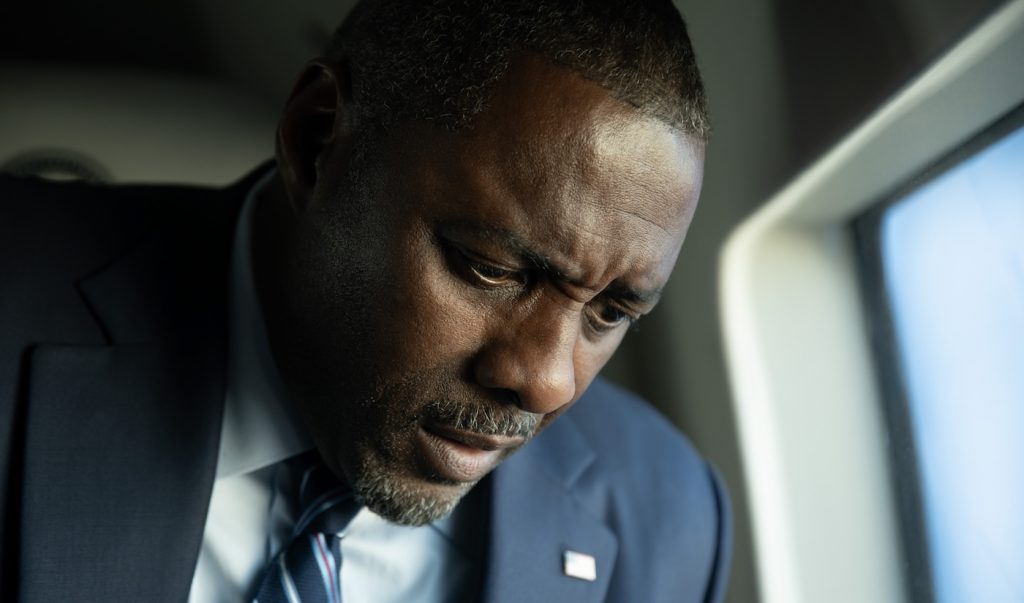“A House of Dynamite”: How Production Designer Jeremy Hindle Built a Nuclear Crisis in Real Time – Part 2
Filmed primarily in New Jersey with the help of $30 million in production incentives, Oscar-winner Kathryn Bigelow’s A House of Dynamite is a sobering look at how the response to a nuclear attack on U.S. soil might unfold. It’s not an easy watch, but it’s relentlessly compelling and superbly crafted, hallmarks of Bigelow’s distinguished career.
The cortisol-triggering film follows major players in the government during the 20 minutes before an inbound nuclear missile hits a major American city. Major sets in the film include: the 49th Missile Defense Battalion in Fort Greely, Alaska, tasked with detecting and neutralizing incoming nuclear threats; US STRATCOM (Strategic Command) led by General Brady (Tracy Letts); the 24/7 intelligence center in the White House Situation Room; and the PEOC (Presidential Emergency Operations Center), a secured communications center underneath the White House in the event of catastrophic emergencies.
It was a Herculean task for Emmy-winning production designer Jeremy Hindle, “because all the main sets had to be ready for day one, since we shot many sets simultaneously,” he says. “Every set had to be live and ready to go with full ceilings and 360-degree access.”
We spoke to the production designer in our two-part deep dive into his meticulous work on Bigelow’s pulse-pounding thriller.
The White House Situation Room is the focal point in the first third of the film, with the “DEFCON” board and a giant communications screen displaying the missile’s real-time trajectory, as well as a conference call involving POTUS (Idris Elba), the Secretary of Defense (Jared Harris), and others. What was it like to build a replica of that room?
How the room functioned was crucial — the screens and phones were all operational, allowing all the characters to interact with each other. Those phones don’t exist, so we had to replicate them. There’s no information on the internet for any of that; we relied on Dan Karbler and other technical advisors. For the line of succession board, what they physically do and look like is not something they can divulge. So, we designed and showed it to them, and they’d say, yes, no, yes, no, yes, looking good, getting better, until we got there. But it’s a movie, and you need people to be able to read it and understand the storyline. So, there are definitely movie moments to make sure the audience can understand what’s happening.

What about the maps and graphics on all those screens, not just in the Sit Room, but also at STRATCOM and Fort Greely?
That was the hardest part. We had to make a 19-minute sequence for all the sets in all the different sequences. One sequence plays through in all the sets simultaneously, but they’re on different screen sizes and types, and not in the same orientation. There was a huge team of playback, and we had an amazing art director, Eric Bryant. We needed it that way so we could shoot all three or four major sets simultaneously with multiple cameras. Those screens were playing live, so every actor could react in real-time and talk to each other. But we had to generate all that ahead of time; we didn’t put in stuff later on the screens. It was all live.
So, when the comms board shows the GBI (Ground-Based Interceptor) failing to intercept the incoming missile on a third try, or adversarial nations initiating potentially retaliatory steps, did your team design all those live graphics?
Yes, all live and simultaneous, just as if it were really happening for the actors. They could pick up the phone and call another set to talk to another actor, go through the motions, and ad-lib. They can do whatever they want. It’s live.
Wow! I didn’t know the phones on those sets were actually working.
Everything was fully operational for the actors.
Can you explain what the playback team does?
The playback team was massive; I’ve never seen more playback in my life! Each screen with all the graphics has a separate driver, so there are hundreds of drivers to get it ready to play back on every set simultaneously on three huge stages. Stage One was the White House Situation Room and the PEOC underground. There’s a guy sitting in the back of a car on the Zoom call. Everyone talking on the conference call is in specific sets. Stage Two was Fort Greeley and STRATCOM, a bunch of smaller Zoom sets, and the basement set where a general was sitting with his washer and dryer behind him. That was a nod to a real general who did that once. We had a small set for Jared Harris (Secretary of Defense) to use for his Zoom call, as we hadn’t finished the Secretary of Defense set yet, so he sat in that little set for weeks. Stage three was the Secretary of Defense’s office, White House Situation Room, White House press briefing room with visual effects out the windows and partial dressing, White House security gate with 360-degree CG outside the windows, and the guard shack with the fence.
That’s an insane number of sets to all have to go live to be filmed simultaneously. What about the PEOC that’s in the East Wing of the White House?
Apparently, that’s probably gone now. I just love that room, which is where President Obama gave the order to get Osama bin Laden. We’ve all seen photographs of it, so it had to be in the movie because that’s a core American battle room. There’s only one photograph of that hallway, I think it was in Eleanor Roosevelt’s published diary. I couldn’t get any intel on what’s underneath the White House. So for those, we did our best based on what we knew. If you watch some of the real footage, people start falling asleep on camera due to a lack of oxygen, because they were down there for so long. Photos of the PEOC are very rare, mostly from when Obama was in it and a few other Presidents.
Let’s talk about the STRATCOM set, which is the second part of the story that focuses on STRATCOM Commander, General Brady (Tracy Letts).
I love that set, it’s intense. The most interesting thing I learned was all the wallpaper in it isn’t wallpaper; it’s metal mesh. The room is a Faraday cage to block electromagnetic charges. It really shows the seriousness of what they deal with every day — to me, that’s the most important thing. So, we tried to match that metallic wallpaper to every detail. That decision room is called the battle deck, it’s multiple stories underground. You really feel the intensity in there. These people work in windowless rooms their whole lives for our safety. We’re very lucky. So I was glad that we nailed that room.

What about that DEFCON board? I assume there are no details on that either?
No, that’s identical to what they use. Most of it, like the cameras that pop up, are just like what you’d see at all these places for real, at least to the best of our knowledge. Of all the movies I’ve worked on, it’s this one where people are really impressed with how much it’s like the real thing. They’re as particular as we are. We’re working with these amazing people, so how could we not make it perfect?
The third part of the movie focuses on POTUS (Idris Elba), but you don’t see him on the conference call during the first two parts. Was that a deliberate choice?
That’s how it was written. And because he’s on a sat phone and being rushed out. They don’t pull him into the call completely until they know what they’re dealing with.

As the countdown narrows to the final minutes, POTUS is rushed onboard Marine One while the Navy officer carrying the nuclear “football” explains his retaliatory nuclear strike options.
We actually had that helicopter made by a company in Atlanta that specializes in restoring them for the Presidential museums. They had the shell of the helicopter and restored the exterior to match a new Marine One. Then, they built the full interior, as we wanted to shoot it as one piece, live, hanging from a crane. So we could have the President pull up to the chopper, enter, and rise during that sequence, so it felt real. We shot Idris hanging from a crane for that whole sequence. Outside the windows is all VFX, because it’s obviously Andrews Air Force Base, which is impossible to film. So, we did it in New Jersey.
That whole sequence was shot inside a helicopter shell on a crane?
Yes! I was scouting the real FEMA command center in New Jersey to see if we could shoot there. They were worried about hurricane season, but we agreed we wouldn’t shoot there if there was a hurricane. So, they let us have it. We also had the helipad to land the Black Hawk for real. Then, we went to an amazing airport with a beautiful original wartime hangar for the B-2 sequences. It’s even more amazing that we got all those locations within 10 minutes of each other, which is what you need for a movie. The New Jersey State Police were unbelievable.
What do you want audiences to get out of this film?
That we’re all collectively humans. She said it best: humanity is at stake. We’re educated about the science and the facts. So why are we doing this? We need to look after each other. I’m baffled that all of this is necessary to protect ourselves. I grew up in the ’80s when there were three countries with nuclear weapons — now there are nine. Am I surprised there hasn’t been an accident? Absolutely. But how much longer can we rely on luck?

[Spoiler ahead] The ending is surprising because we don’t see the detonation or fallout aftermath. What do you make of that?
It’s such a powerful ending that leaves you with a blank stare. I love it because if it frustrates you, then do something about it. If there were closure, it would just be a movie. But if you’re upset and worried, you don’t get to leave with this happy pill at the end that allows you to dismiss it as a movie and move on. Kathryn’s not going to let you do that. You’ve got to go home, think about it, and talk about it. I think that’s the only ending possible. Now the conversation is: ‘Why are we doing this? Why is this the system?’
A House of Dynamite is streaming on Netflix.
Featured image: A HOUSE OF DYNAMITE – (Featured) Kyle Allen as Captain Jon Zimmer. Photo by Eros Hoagland. © 2025 Netflix, Inc.



